Factors Influencing Employee Turnover in Hospitality Sector
VerifiedAdded on 2022/10/02
|11
|3412
|292
AI Summary
This literature review discusses the factors leading to employee turnover in the hospitality sector. It includes an exhaustive discussion regarding external factors, personal factors and work-related factors. The paper concludes by presenting a summary of the key findings followed by a recommendation for addressing the concern or potentiality of employee turnover in an organization.
Contribute Materials
Your contribution can guide someone’s learning journey. Share your
documents today.
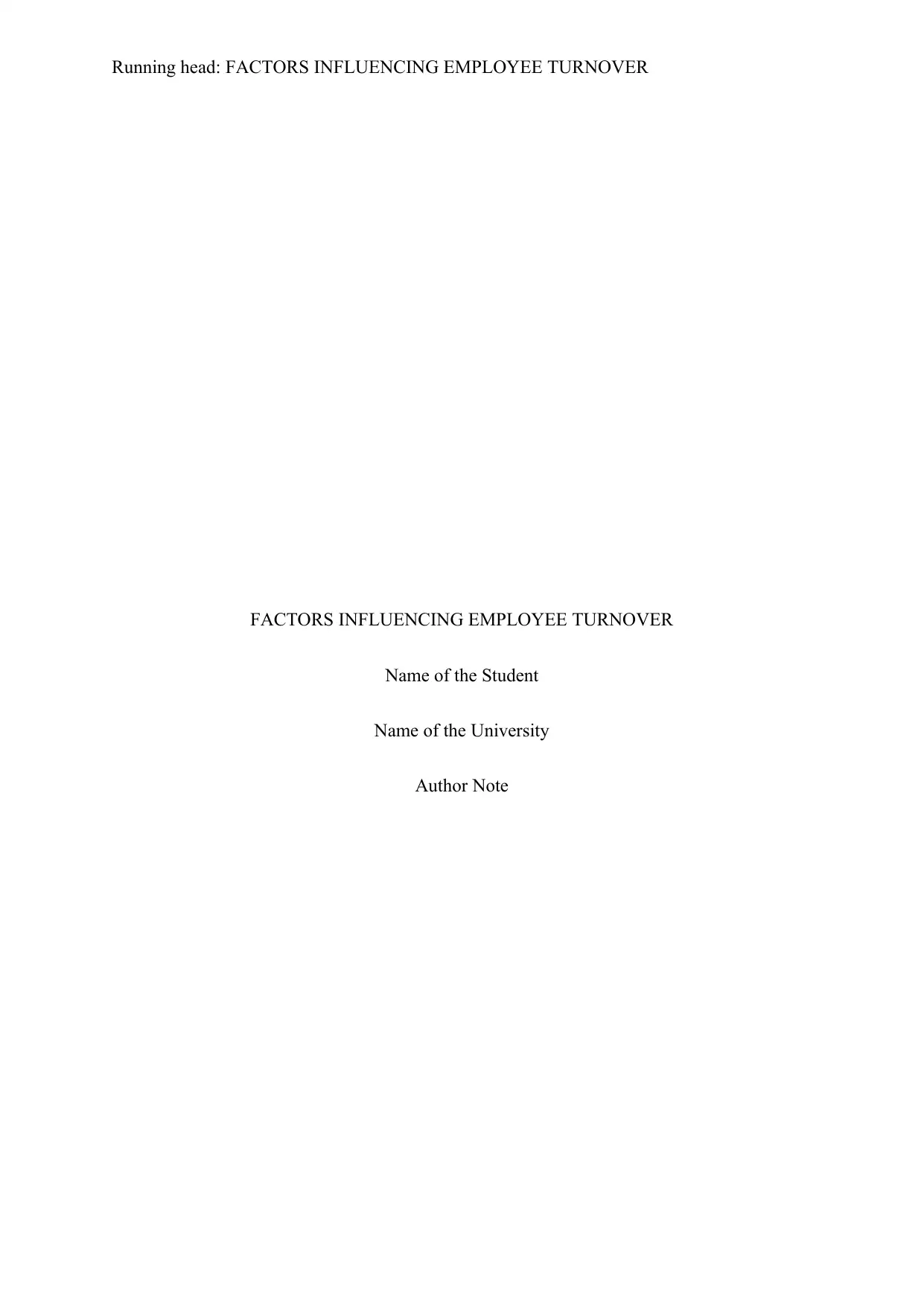
Running head: FACTORS INFLUENCING EMPLOYEE TURNOVER
FACTORS INFLUENCING EMPLOYEE TURNOVER
Name of the Student
Name of the University
Author Note
FACTORS INFLUENCING EMPLOYEE TURNOVER
Name of the Student
Name of the University
Author Note
Secure Best Marks with AI Grader
Need help grading? Try our AI Grader for instant feedback on your assignments.
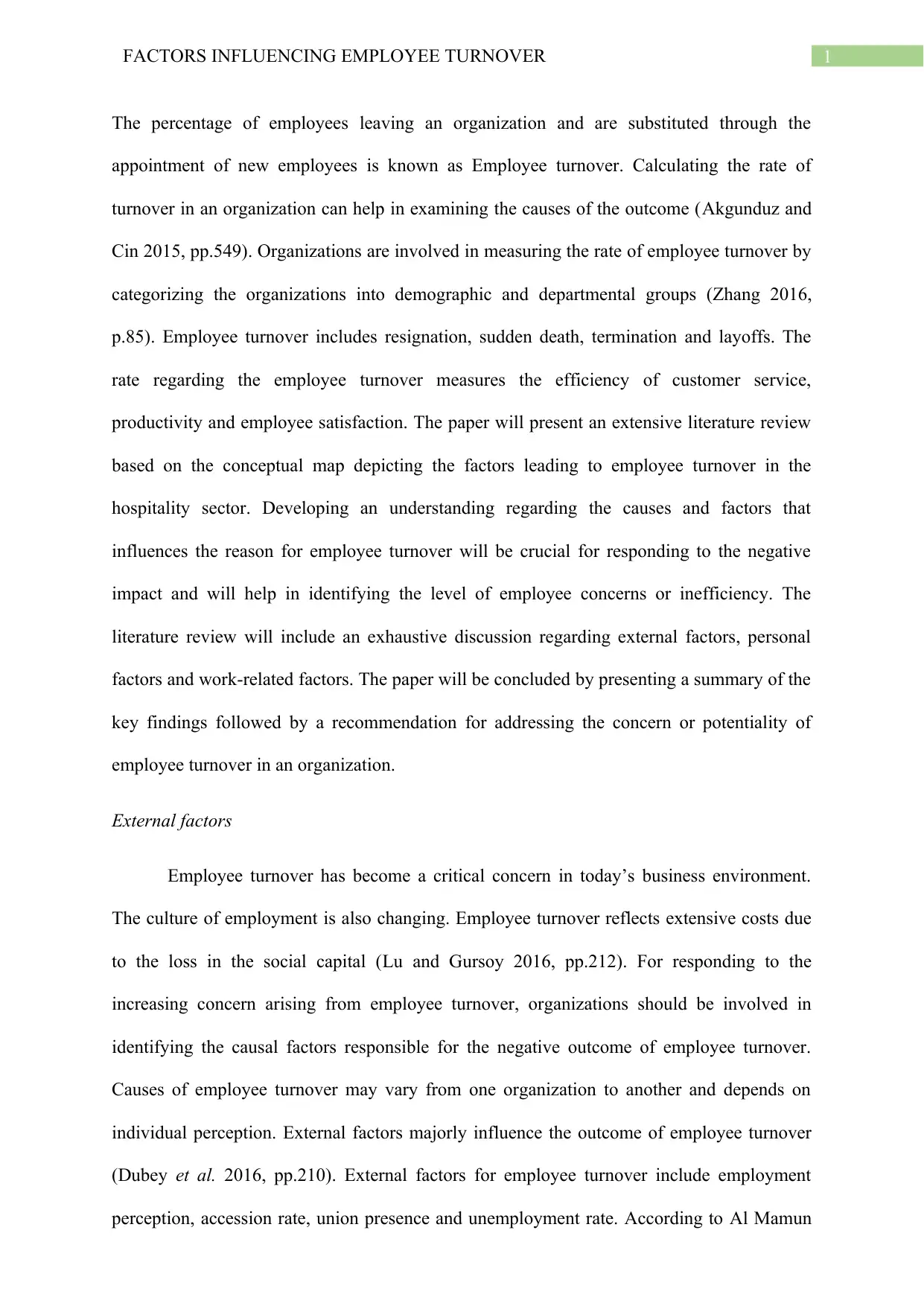
1FACTORS INFLUENCING EMPLOYEE TURNOVER
The percentage of employees leaving an organization and are substituted through the
appointment of new employees is known as Employee turnover. Calculating the rate of
turnover in an organization can help in examining the causes of the outcome (Akgunduz and
Cin 2015, pp.549). Organizations are involved in measuring the rate of employee turnover by
categorizing the organizations into demographic and departmental groups (Zhang 2016,
p.85). Employee turnover includes resignation, sudden death, termination and layoffs. The
rate regarding the employee turnover measures the efficiency of customer service,
productivity and employee satisfaction. The paper will present an extensive literature review
based on the conceptual map depicting the factors leading to employee turnover in the
hospitality sector. Developing an understanding regarding the causes and factors that
influences the reason for employee turnover will be crucial for responding to the negative
impact and will help in identifying the level of employee concerns or inefficiency. The
literature review will include an exhaustive discussion regarding external factors, personal
factors and work-related factors. The paper will be concluded by presenting a summary of the
key findings followed by a recommendation for addressing the concern or potentiality of
employee turnover in an organization.
External factors
Employee turnover has become a critical concern in today’s business environment.
The culture of employment is also changing. Employee turnover reflects extensive costs due
to the loss in the social capital (Lu and Gursoy 2016, pp.212). For responding to the
increasing concern arising from employee turnover, organizations should be involved in
identifying the causal factors responsible for the negative outcome of employee turnover.
Causes of employee turnover may vary from one organization to another and depends on
individual perception. External factors majorly influence the outcome of employee turnover
(Dubey et al. 2016, pp.210). External factors for employee turnover include employment
perception, accession rate, union presence and unemployment rate. According to Al Mamun
The percentage of employees leaving an organization and are substituted through the
appointment of new employees is known as Employee turnover. Calculating the rate of
turnover in an organization can help in examining the causes of the outcome (Akgunduz and
Cin 2015, pp.549). Organizations are involved in measuring the rate of employee turnover by
categorizing the organizations into demographic and departmental groups (Zhang 2016,
p.85). Employee turnover includes resignation, sudden death, termination and layoffs. The
rate regarding the employee turnover measures the efficiency of customer service,
productivity and employee satisfaction. The paper will present an extensive literature review
based on the conceptual map depicting the factors leading to employee turnover in the
hospitality sector. Developing an understanding regarding the causes and factors that
influences the reason for employee turnover will be crucial for responding to the negative
impact and will help in identifying the level of employee concerns or inefficiency. The
literature review will include an exhaustive discussion regarding external factors, personal
factors and work-related factors. The paper will be concluded by presenting a summary of the
key findings followed by a recommendation for addressing the concern or potentiality of
employee turnover in an organization.
External factors
Employee turnover has become a critical concern in today’s business environment.
The culture of employment is also changing. Employee turnover reflects extensive costs due
to the loss in the social capital (Lu and Gursoy 2016, pp.212). For responding to the
increasing concern arising from employee turnover, organizations should be involved in
identifying the causal factors responsible for the negative outcome of employee turnover.
Causes of employee turnover may vary from one organization to another and depends on
individual perception. External factors majorly influence the outcome of employee turnover
(Dubey et al. 2016, pp.210). External factors for employee turnover include employment
perception, accession rate, union presence and unemployment rate. According to Al Mamun
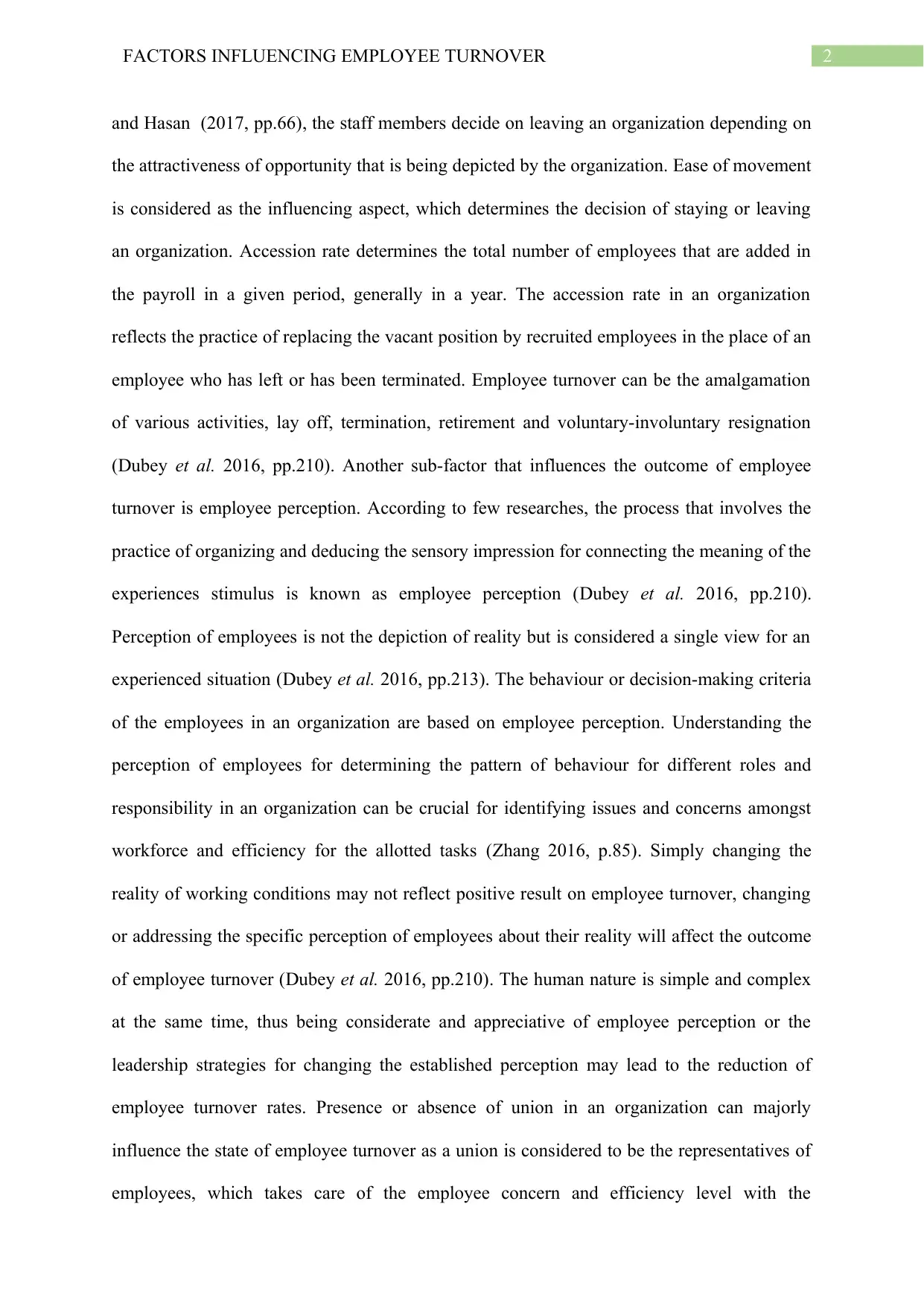
2FACTORS INFLUENCING EMPLOYEE TURNOVER
and Hasan (2017, pp.66), the staff members decide on leaving an organization depending on
the attractiveness of opportunity that is being depicted by the organization. Ease of movement
is considered as the influencing aspect, which determines the decision of staying or leaving
an organization. Accession rate determines the total number of employees that are added in
the payroll in a given period, generally in a year. The accession rate in an organization
reflects the practice of replacing the vacant position by recruited employees in the place of an
employee who has left or has been terminated. Employee turnover can be the amalgamation
of various activities, lay off, termination, retirement and voluntary-involuntary resignation
(Dubey et al. 2016, pp.210). Another sub-factor that influences the outcome of employee
turnover is employee perception. According to few researches, the process that involves the
practice of organizing and deducing the sensory impression for connecting the meaning of the
experiences stimulus is known as employee perception (Dubey et al. 2016, pp.210).
Perception of employees is not the depiction of reality but is considered a single view for an
experienced situation (Dubey et al. 2016, pp.213). The behaviour or decision-making criteria
of the employees in an organization are based on employee perception. Understanding the
perception of employees for determining the pattern of behaviour for different roles and
responsibility in an organization can be crucial for identifying issues and concerns amongst
workforce and efficiency for the allotted tasks (Zhang 2016, p.85). Simply changing the
reality of working conditions may not reflect positive result on employee turnover, changing
or addressing the specific perception of employees about their reality will affect the outcome
of employee turnover (Dubey et al. 2016, pp.210). The human nature is simple and complex
at the same time, thus being considerate and appreciative of employee perception or the
leadership strategies for changing the established perception may lead to the reduction of
employee turnover rates. Presence or absence of union in an organization can majorly
influence the state of employee turnover as a union is considered to be the representatives of
employees, which takes care of the employee concern and efficiency level with the
and Hasan (2017, pp.66), the staff members decide on leaving an organization depending on
the attractiveness of opportunity that is being depicted by the organization. Ease of movement
is considered as the influencing aspect, which determines the decision of staying or leaving
an organization. Accession rate determines the total number of employees that are added in
the payroll in a given period, generally in a year. The accession rate in an organization
reflects the practice of replacing the vacant position by recruited employees in the place of an
employee who has left or has been terminated. Employee turnover can be the amalgamation
of various activities, lay off, termination, retirement and voluntary-involuntary resignation
(Dubey et al. 2016, pp.210). Another sub-factor that influences the outcome of employee
turnover is employee perception. According to few researches, the process that involves the
practice of organizing and deducing the sensory impression for connecting the meaning of the
experiences stimulus is known as employee perception (Dubey et al. 2016, pp.210).
Perception of employees is not the depiction of reality but is considered a single view for an
experienced situation (Dubey et al. 2016, pp.213). The behaviour or decision-making criteria
of the employees in an organization are based on employee perception. Understanding the
perception of employees for determining the pattern of behaviour for different roles and
responsibility in an organization can be crucial for identifying issues and concerns amongst
workforce and efficiency for the allotted tasks (Zhang 2016, p.85). Simply changing the
reality of working conditions may not reflect positive result on employee turnover, changing
or addressing the specific perception of employees about their reality will affect the outcome
of employee turnover (Dubey et al. 2016, pp.210). The human nature is simple and complex
at the same time, thus being considerate and appreciative of employee perception or the
leadership strategies for changing the established perception may lead to the reduction of
employee turnover rates. Presence or absence of union in an organization can majorly
influence the state of employee turnover as a union is considered to be the representatives of
employees, which takes care of the employee concern and efficiency level with the
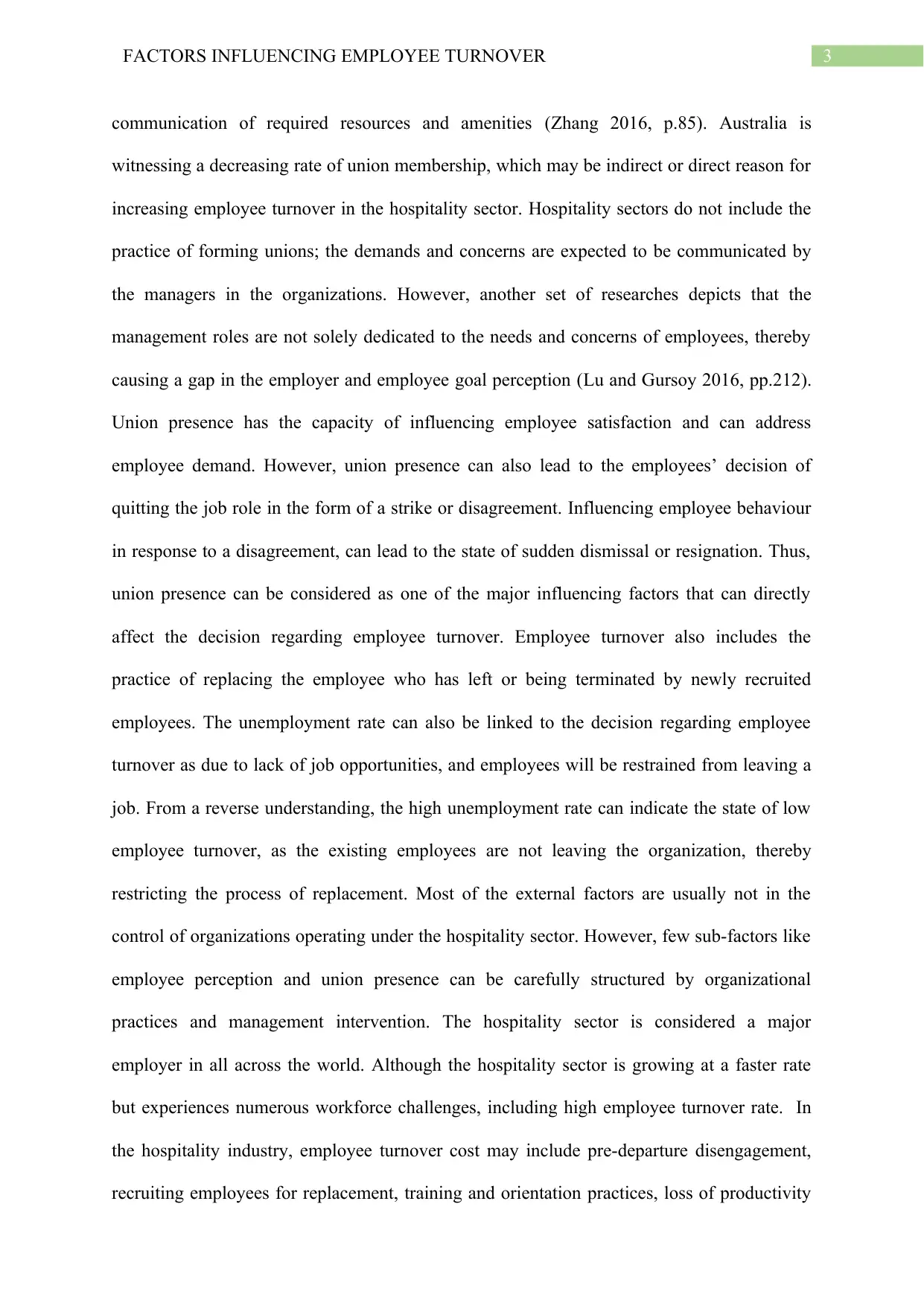
3FACTORS INFLUENCING EMPLOYEE TURNOVER
communication of required resources and amenities (Zhang 2016, p.85). Australia is
witnessing a decreasing rate of union membership, which may be indirect or direct reason for
increasing employee turnover in the hospitality sector. Hospitality sectors do not include the
practice of forming unions; the demands and concerns are expected to be communicated by
the managers in the organizations. However, another set of researches depicts that the
management roles are not solely dedicated to the needs and concerns of employees, thereby
causing a gap in the employer and employee goal perception (Lu and Gursoy 2016, pp.212).
Union presence has the capacity of influencing employee satisfaction and can address
employee demand. However, union presence can also lead to the employees’ decision of
quitting the job role in the form of a strike or disagreement. Influencing employee behaviour
in response to a disagreement, can lead to the state of sudden dismissal or resignation. Thus,
union presence can be considered as one of the major influencing factors that can directly
affect the decision regarding employee turnover. Employee turnover also includes the
practice of replacing the employee who has left or being terminated by newly recruited
employees. The unemployment rate can also be linked to the decision regarding employee
turnover as due to lack of job opportunities, and employees will be restrained from leaving a
job. From a reverse understanding, the high unemployment rate can indicate the state of low
employee turnover, as the existing employees are not leaving the organization, thereby
restricting the process of replacement. Most of the external factors are usually not in the
control of organizations operating under the hospitality sector. However, few sub-factors like
employee perception and union presence can be carefully structured by organizational
practices and management intervention. The hospitality sector is considered a major
employer in all across the world. Although the hospitality sector is growing at a faster rate
but experiences numerous workforce challenges, including high employee turnover rate. In
the hospitality industry, employee turnover cost may include pre-departure disengagement,
recruiting employees for replacement, training and orientation practices, loss of productivity
communication of required resources and amenities (Zhang 2016, p.85). Australia is
witnessing a decreasing rate of union membership, which may be indirect or direct reason for
increasing employee turnover in the hospitality sector. Hospitality sectors do not include the
practice of forming unions; the demands and concerns are expected to be communicated by
the managers in the organizations. However, another set of researches depicts that the
management roles are not solely dedicated to the needs and concerns of employees, thereby
causing a gap in the employer and employee goal perception (Lu and Gursoy 2016, pp.212).
Union presence has the capacity of influencing employee satisfaction and can address
employee demand. However, union presence can also lead to the employees’ decision of
quitting the job role in the form of a strike or disagreement. Influencing employee behaviour
in response to a disagreement, can lead to the state of sudden dismissal or resignation. Thus,
union presence can be considered as one of the major influencing factors that can directly
affect the decision regarding employee turnover. Employee turnover also includes the
practice of replacing the employee who has left or being terminated by newly recruited
employees. The unemployment rate can also be linked to the decision regarding employee
turnover as due to lack of job opportunities, and employees will be restrained from leaving a
job. From a reverse understanding, the high unemployment rate can indicate the state of low
employee turnover, as the existing employees are not leaving the organization, thereby
restricting the process of replacement. Most of the external factors are usually not in the
control of organizations operating under the hospitality sector. However, few sub-factors like
employee perception and union presence can be carefully structured by organizational
practices and management intervention. The hospitality sector is considered a major
employer in all across the world. Although the hospitality sector is growing at a faster rate
but experiences numerous workforce challenges, including high employee turnover rate. In
the hospitality industry, employee turnover cost may include pre-departure disengagement,
recruiting employees for replacement, training and orientation practices, loss of productivity
Secure Best Marks with AI Grader
Need help grading? Try our AI Grader for instant feedback on your assignments.
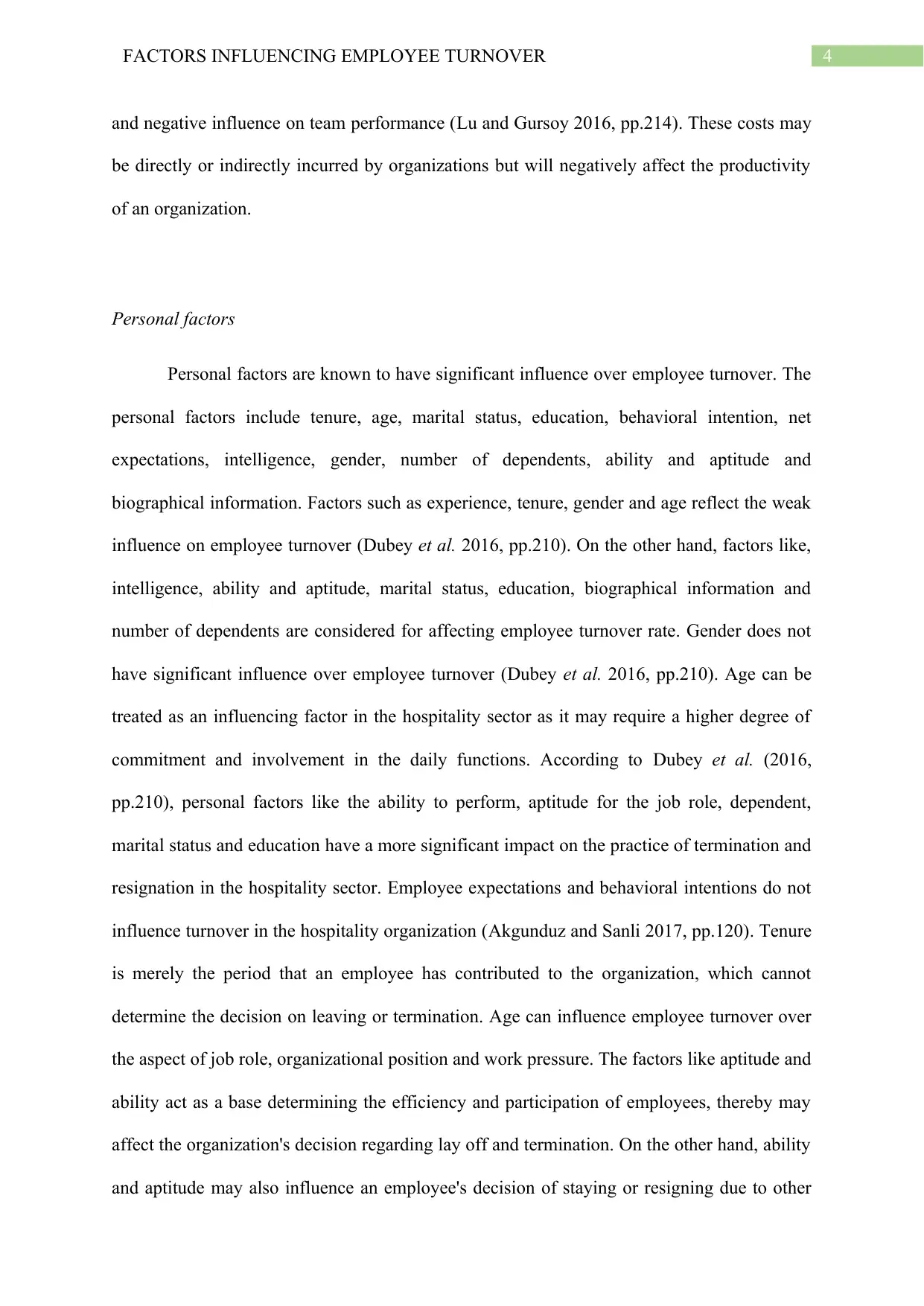
4FACTORS INFLUENCING EMPLOYEE TURNOVER
and negative influence on team performance (Lu and Gursoy 2016, pp.214). These costs may
be directly or indirectly incurred by organizations but will negatively affect the productivity
of an organization.
Personal factors
Personal factors are known to have significant influence over employee turnover. The
personal factors include tenure, age, marital status, education, behavioral intention, net
expectations, intelligence, gender, number of dependents, ability and aptitude and
biographical information. Factors such as experience, tenure, gender and age reflect the weak
influence on employee turnover (Dubey et al. 2016, pp.210). On the other hand, factors like,
intelligence, ability and aptitude, marital status, education, biographical information and
number of dependents are considered for affecting employee turnover rate. Gender does not
have significant influence over employee turnover (Dubey et al. 2016, pp.210). Age can be
treated as an influencing factor in the hospitality sector as it may require a higher degree of
commitment and involvement in the daily functions. According to Dubey et al. (2016,
pp.210), personal factors like the ability to perform, aptitude for the job role, dependent,
marital status and education have a more significant impact on the practice of termination and
resignation in the hospitality sector. Employee expectations and behavioral intentions do not
influence turnover in the hospitality organization (Akgunduz and Sanli 2017, pp.120). Tenure
is merely the period that an employee has contributed to the organization, which cannot
determine the decision on leaving or termination. Age can influence employee turnover over
the aspect of job role, organizational position and work pressure. The factors like aptitude and
ability act as a base determining the efficiency and participation of employees, thereby may
affect the organization's decision regarding lay off and termination. On the other hand, ability
and aptitude may also influence an employee's decision of staying or resigning due to other
and negative influence on team performance (Lu and Gursoy 2016, pp.214). These costs may
be directly or indirectly incurred by organizations but will negatively affect the productivity
of an organization.
Personal factors
Personal factors are known to have significant influence over employee turnover. The
personal factors include tenure, age, marital status, education, behavioral intention, net
expectations, intelligence, gender, number of dependents, ability and aptitude and
biographical information. Factors such as experience, tenure, gender and age reflect the weak
influence on employee turnover (Dubey et al. 2016, pp.210). On the other hand, factors like,
intelligence, ability and aptitude, marital status, education, biographical information and
number of dependents are considered for affecting employee turnover rate. Gender does not
have significant influence over employee turnover (Dubey et al. 2016, pp.210). Age can be
treated as an influencing factor in the hospitality sector as it may require a higher degree of
commitment and involvement in the daily functions. According to Dubey et al. (2016,
pp.210), personal factors like the ability to perform, aptitude for the job role, dependent,
marital status and education have a more significant impact on the practice of termination and
resignation in the hospitality sector. Employee expectations and behavioral intentions do not
influence turnover in the hospitality organization (Akgunduz and Sanli 2017, pp.120). Tenure
is merely the period that an employee has contributed to the organization, which cannot
determine the decision on leaving or termination. Age can influence employee turnover over
the aspect of job role, organizational position and work pressure. The factors like aptitude and
ability act as a base determining the efficiency and participation of employees, thereby may
affect the organization's decision regarding lay off and termination. On the other hand, ability
and aptitude may also influence an employee's decision of staying or resigning due to other
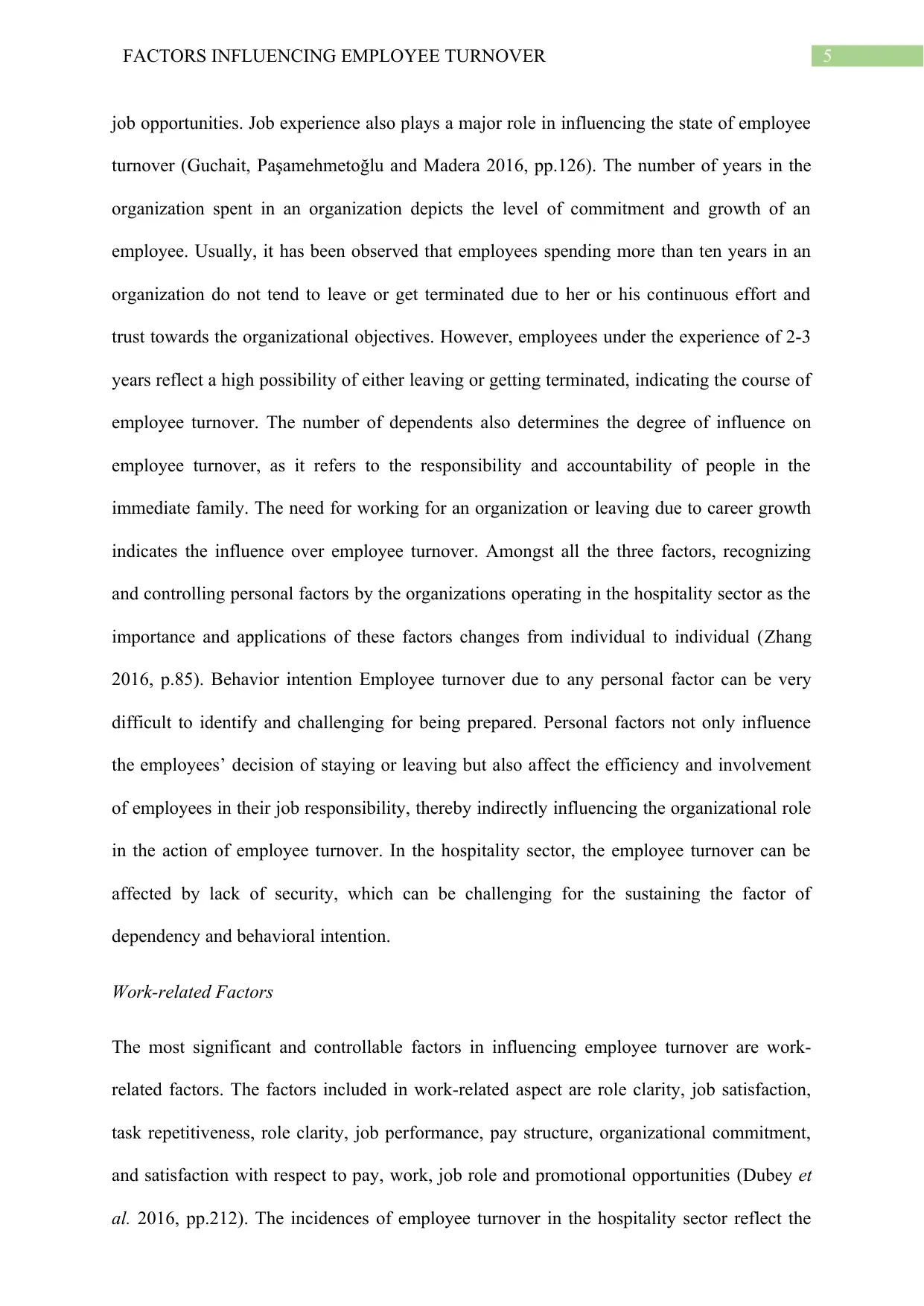
5FACTORS INFLUENCING EMPLOYEE TURNOVER
job opportunities. Job experience also plays a major role in influencing the state of employee
turnover (Guchait, Paşamehmetoğlu and Madera 2016, pp.126). The number of years in the
organization spent in an organization depicts the level of commitment and growth of an
employee. Usually, it has been observed that employees spending more than ten years in an
organization do not tend to leave or get terminated due to her or his continuous effort and
trust towards the organizational objectives. However, employees under the experience of 2-3
years reflect a high possibility of either leaving or getting terminated, indicating the course of
employee turnover. The number of dependents also determines the degree of influence on
employee turnover, as it refers to the responsibility and accountability of people in the
immediate family. The need for working for an organization or leaving due to career growth
indicates the influence over employee turnover. Amongst all the three factors, recognizing
and controlling personal factors by the organizations operating in the hospitality sector as the
importance and applications of these factors changes from individual to individual (Zhang
2016, p.85). Behavior intention Employee turnover due to any personal factor can be very
difficult to identify and challenging for being prepared. Personal factors not only influence
the employees’ decision of staying or leaving but also affect the efficiency and involvement
of employees in their job responsibility, thereby indirectly influencing the organizational role
in the action of employee turnover. In the hospitality sector, the employee turnover can be
affected by lack of security, which can be challenging for the sustaining the factor of
dependency and behavioral intention.
Work-related Factors
The most significant and controllable factors in influencing employee turnover are work-
related factors. The factors included in work-related aspect are role clarity, job satisfaction,
task repetitiveness, role clarity, job performance, pay structure, organizational commitment,
and satisfaction with respect to pay, work, job role and promotional opportunities (Dubey et
al. 2016, pp.212). The incidences of employee turnover in the hospitality sector reflect the
job opportunities. Job experience also plays a major role in influencing the state of employee
turnover (Guchait, Paşamehmetoğlu and Madera 2016, pp.126). The number of years in the
organization spent in an organization depicts the level of commitment and growth of an
employee. Usually, it has been observed that employees spending more than ten years in an
organization do not tend to leave or get terminated due to her or his continuous effort and
trust towards the organizational objectives. However, employees under the experience of 2-3
years reflect a high possibility of either leaving or getting terminated, indicating the course of
employee turnover. The number of dependents also determines the degree of influence on
employee turnover, as it refers to the responsibility and accountability of people in the
immediate family. The need for working for an organization or leaving due to career growth
indicates the influence over employee turnover. Amongst all the three factors, recognizing
and controlling personal factors by the organizations operating in the hospitality sector as the
importance and applications of these factors changes from individual to individual (Zhang
2016, p.85). Behavior intention Employee turnover due to any personal factor can be very
difficult to identify and challenging for being prepared. Personal factors not only influence
the employees’ decision of staying or leaving but also affect the efficiency and involvement
of employees in their job responsibility, thereby indirectly influencing the organizational role
in the action of employee turnover. In the hospitality sector, the employee turnover can be
affected by lack of security, which can be challenging for the sustaining the factor of
dependency and behavioral intention.
Work-related Factors
The most significant and controllable factors in influencing employee turnover are work-
related factors. The factors included in work-related aspect are role clarity, job satisfaction,
task repetitiveness, role clarity, job performance, pay structure, organizational commitment,
and satisfaction with respect to pay, work, job role and promotional opportunities (Dubey et
al. 2016, pp.212). The incidences of employee turnover in the hospitality sector reflect the
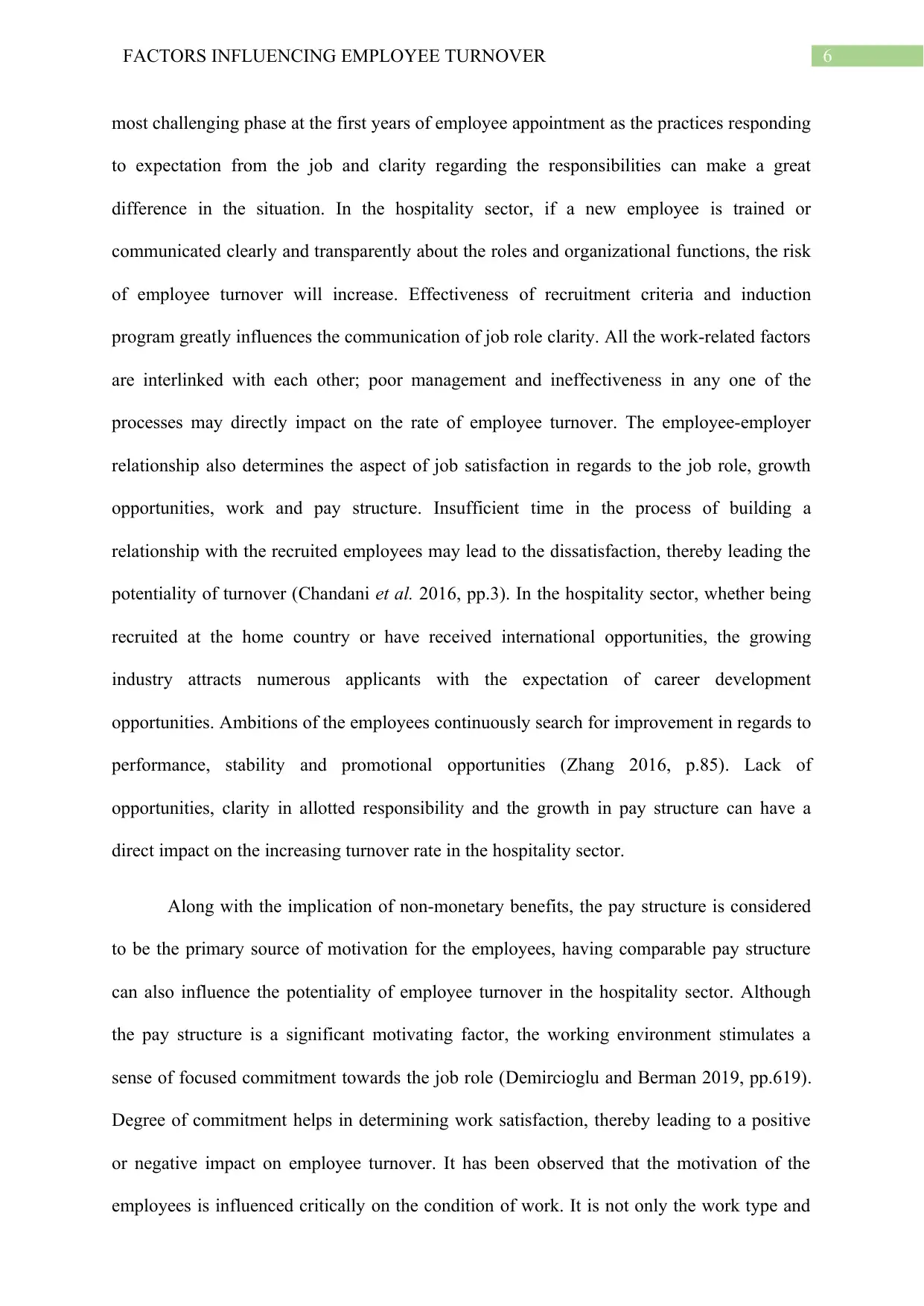
6FACTORS INFLUENCING EMPLOYEE TURNOVER
most challenging phase at the first years of employee appointment as the practices responding
to expectation from the job and clarity regarding the responsibilities can make a great
difference in the situation. In the hospitality sector, if a new employee is trained or
communicated clearly and transparently about the roles and organizational functions, the risk
of employee turnover will increase. Effectiveness of recruitment criteria and induction
program greatly influences the communication of job role clarity. All the work-related factors
are interlinked with each other; poor management and ineffectiveness in any one of the
processes may directly impact on the rate of employee turnover. The employee-employer
relationship also determines the aspect of job satisfaction in regards to the job role, growth
opportunities, work and pay structure. Insufficient time in the process of building a
relationship with the recruited employees may lead to the dissatisfaction, thereby leading the
potentiality of turnover (Chandani et al. 2016, pp.3). In the hospitality sector, whether being
recruited at the home country or have received international opportunities, the growing
industry attracts numerous applicants with the expectation of career development
opportunities. Ambitions of the employees continuously search for improvement in regards to
performance, stability and promotional opportunities (Zhang 2016, p.85). Lack of
opportunities, clarity in allotted responsibility and the growth in pay structure can have a
direct impact on the increasing turnover rate in the hospitality sector.
Along with the implication of non-monetary benefits, the pay structure is considered
to be the primary source of motivation for the employees, having comparable pay structure
can also influence the potentiality of employee turnover in the hospitality sector. Although
the pay structure is a significant motivating factor, the working environment stimulates a
sense of focused commitment towards the job role (Demircioglu and Berman 2019, pp.619).
Degree of commitment helps in determining work satisfaction, thereby leading to a positive
or negative impact on employee turnover. It has been observed that the motivation of the
employees is influenced critically on the condition of work. It is not only the work type and
most challenging phase at the first years of employee appointment as the practices responding
to expectation from the job and clarity regarding the responsibilities can make a great
difference in the situation. In the hospitality sector, if a new employee is trained or
communicated clearly and transparently about the roles and organizational functions, the risk
of employee turnover will increase. Effectiveness of recruitment criteria and induction
program greatly influences the communication of job role clarity. All the work-related factors
are interlinked with each other; poor management and ineffectiveness in any one of the
processes may directly impact on the rate of employee turnover. The employee-employer
relationship also determines the aspect of job satisfaction in regards to the job role, growth
opportunities, work and pay structure. Insufficient time in the process of building a
relationship with the recruited employees may lead to the dissatisfaction, thereby leading the
potentiality of turnover (Chandani et al. 2016, pp.3). In the hospitality sector, whether being
recruited at the home country or have received international opportunities, the growing
industry attracts numerous applicants with the expectation of career development
opportunities. Ambitions of the employees continuously search for improvement in regards to
performance, stability and promotional opportunities (Zhang 2016, p.85). Lack of
opportunities, clarity in allotted responsibility and the growth in pay structure can have a
direct impact on the increasing turnover rate in the hospitality sector.
Along with the implication of non-monetary benefits, the pay structure is considered
to be the primary source of motivation for the employees, having comparable pay structure
can also influence the potentiality of employee turnover in the hospitality sector. Although
the pay structure is a significant motivating factor, the working environment stimulates a
sense of focused commitment towards the job role (Demircioglu and Berman 2019, pp.619).
Degree of commitment helps in determining work satisfaction, thereby leading to a positive
or negative impact on employee turnover. It has been observed that the motivation of the
employees is influenced critically on the condition of work. It is not only the work type and
Paraphrase This Document
Need a fresh take? Get an instant paraphrase of this document with our AI Paraphraser
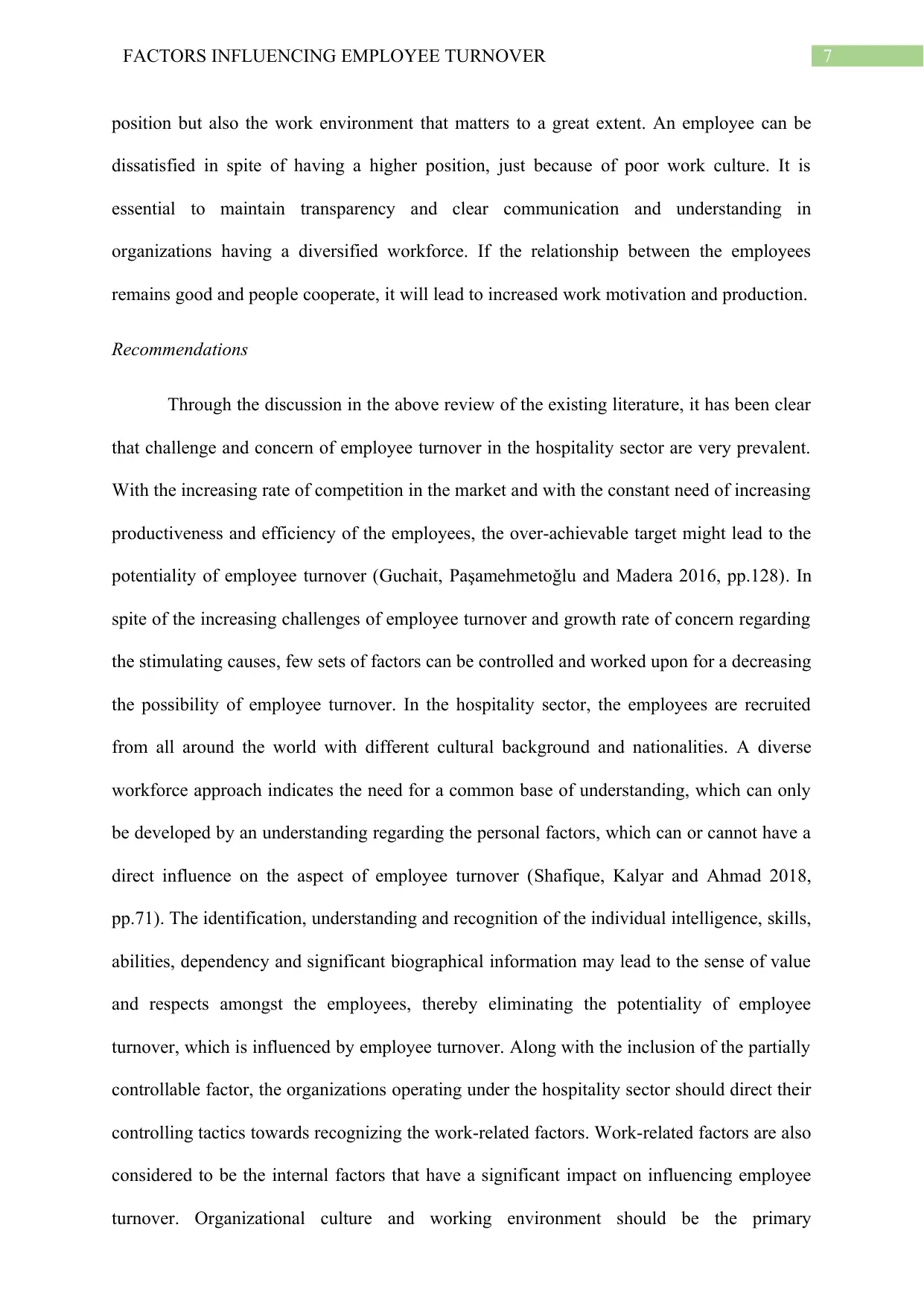
7FACTORS INFLUENCING EMPLOYEE TURNOVER
position but also the work environment that matters to a great extent. An employee can be
dissatisfied in spite of having a higher position, just because of poor work culture. It is
essential to maintain transparency and clear communication and understanding in
organizations having a diversified workforce. If the relationship between the employees
remains good and people cooperate, it will lead to increased work motivation and production.
Recommendations
Through the discussion in the above review of the existing literature, it has been clear
that challenge and concern of employee turnover in the hospitality sector are very prevalent.
With the increasing rate of competition in the market and with the constant need of increasing
productiveness and efficiency of the employees, the over-achievable target might lead to the
potentiality of employee turnover (Guchait, Paşamehmetoğlu and Madera 2016, pp.128). In
spite of the increasing challenges of employee turnover and growth rate of concern regarding
the stimulating causes, few sets of factors can be controlled and worked upon for a decreasing
the possibility of employee turnover. In the hospitality sector, the employees are recruited
from all around the world with different cultural background and nationalities. A diverse
workforce approach indicates the need for a common base of understanding, which can only
be developed by an understanding regarding the personal factors, which can or cannot have a
direct influence on the aspect of employee turnover (Shafique, Kalyar and Ahmad 2018,
pp.71). The identification, understanding and recognition of the individual intelligence, skills,
abilities, dependency and significant biographical information may lead to the sense of value
and respects amongst the employees, thereby eliminating the potentiality of employee
turnover, which is influenced by employee turnover. Along with the inclusion of the partially
controllable factor, the organizations operating under the hospitality sector should direct their
controlling tactics towards recognizing the work-related factors. Work-related factors are also
considered to be the internal factors that have a significant impact on influencing employee
turnover. Organizational culture and working environment should be the primary
position but also the work environment that matters to a great extent. An employee can be
dissatisfied in spite of having a higher position, just because of poor work culture. It is
essential to maintain transparency and clear communication and understanding in
organizations having a diversified workforce. If the relationship between the employees
remains good and people cooperate, it will lead to increased work motivation and production.
Recommendations
Through the discussion in the above review of the existing literature, it has been clear
that challenge and concern of employee turnover in the hospitality sector are very prevalent.
With the increasing rate of competition in the market and with the constant need of increasing
productiveness and efficiency of the employees, the over-achievable target might lead to the
potentiality of employee turnover (Guchait, Paşamehmetoğlu and Madera 2016, pp.128). In
spite of the increasing challenges of employee turnover and growth rate of concern regarding
the stimulating causes, few sets of factors can be controlled and worked upon for a decreasing
the possibility of employee turnover. In the hospitality sector, the employees are recruited
from all around the world with different cultural background and nationalities. A diverse
workforce approach indicates the need for a common base of understanding, which can only
be developed by an understanding regarding the personal factors, which can or cannot have a
direct influence on the aspect of employee turnover (Shafique, Kalyar and Ahmad 2018,
pp.71). The identification, understanding and recognition of the individual intelligence, skills,
abilities, dependency and significant biographical information may lead to the sense of value
and respects amongst the employees, thereby eliminating the potentiality of employee
turnover, which is influenced by employee turnover. Along with the inclusion of the partially
controllable factor, the organizations operating under the hospitality sector should direct their
controlling tactics towards recognizing the work-related factors. Work-related factors are also
considered to be the internal factors that have a significant impact on influencing employee
turnover. Organizational culture and working environment should be the primary
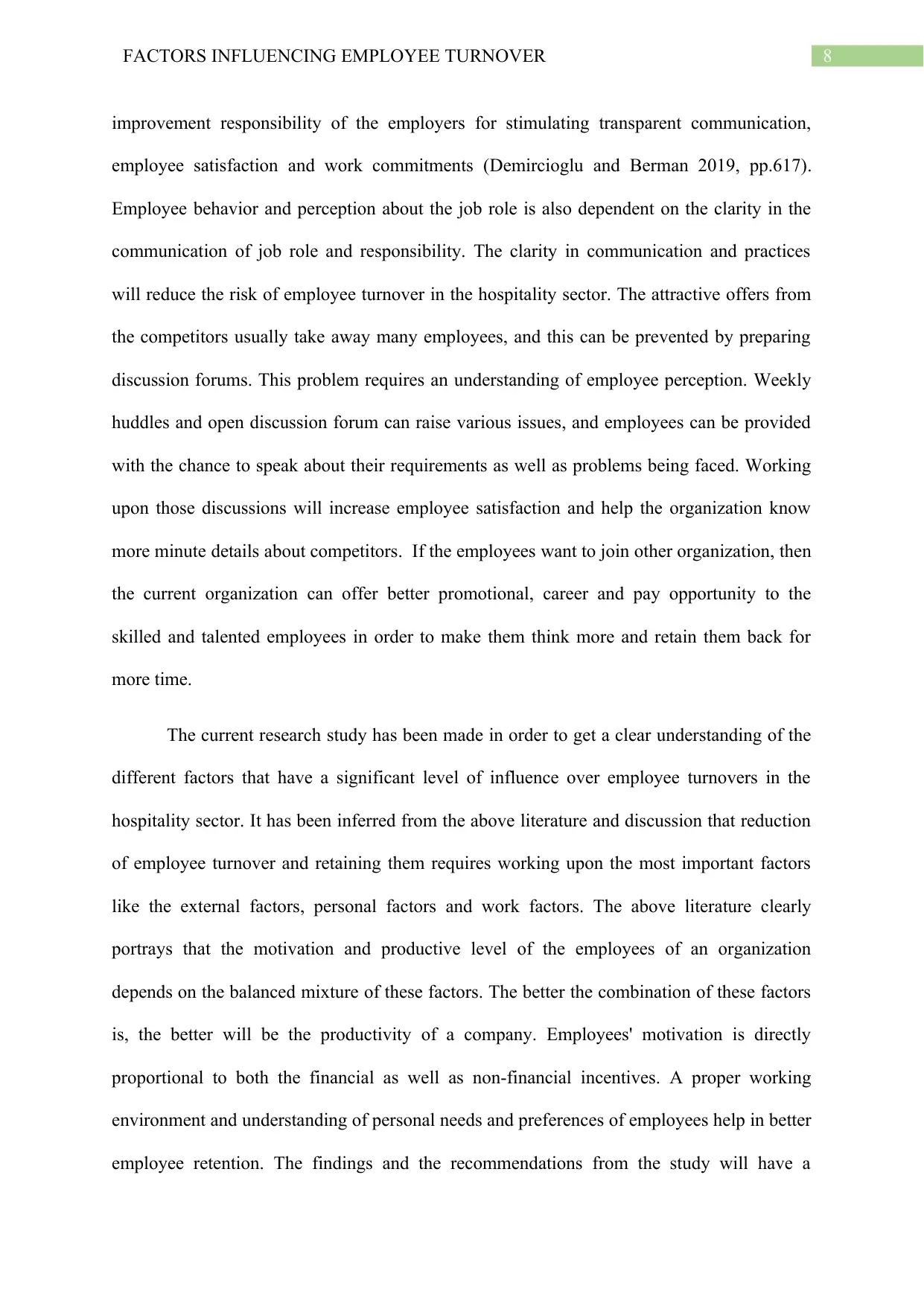
8FACTORS INFLUENCING EMPLOYEE TURNOVER
improvement responsibility of the employers for stimulating transparent communication,
employee satisfaction and work commitments (Demircioglu and Berman 2019, pp.617).
Employee behavior and perception about the job role is also dependent on the clarity in the
communication of job role and responsibility. The clarity in communication and practices
will reduce the risk of employee turnover in the hospitality sector. The attractive offers from
the competitors usually take away many employees, and this can be prevented by preparing
discussion forums. This problem requires an understanding of employee perception. Weekly
huddles and open discussion forum can raise various issues, and employees can be provided
with the chance to speak about their requirements as well as problems being faced. Working
upon those discussions will increase employee satisfaction and help the organization know
more minute details about competitors. If the employees want to join other organization, then
the current organization can offer better promotional, career and pay opportunity to the
skilled and talented employees in order to make them think more and retain them back for
more time.
The current research study has been made in order to get a clear understanding of the
different factors that have a significant level of influence over employee turnovers in the
hospitality sector. It has been inferred from the above literature and discussion that reduction
of employee turnover and retaining them requires working upon the most important factors
like the external factors, personal factors and work factors. The above literature clearly
portrays that the motivation and productive level of the employees of an organization
depends on the balanced mixture of these factors. The better the combination of these factors
is, the better will be the productivity of a company. Employees' motivation is directly
proportional to both the financial as well as non-financial incentives. A proper working
environment and understanding of personal needs and preferences of employees help in better
employee retention. The findings and the recommendations from the study will have a
improvement responsibility of the employers for stimulating transparent communication,
employee satisfaction and work commitments (Demircioglu and Berman 2019, pp.617).
Employee behavior and perception about the job role is also dependent on the clarity in the
communication of job role and responsibility. The clarity in communication and practices
will reduce the risk of employee turnover in the hospitality sector. The attractive offers from
the competitors usually take away many employees, and this can be prevented by preparing
discussion forums. This problem requires an understanding of employee perception. Weekly
huddles and open discussion forum can raise various issues, and employees can be provided
with the chance to speak about their requirements as well as problems being faced. Working
upon those discussions will increase employee satisfaction and help the organization know
more minute details about competitors. If the employees want to join other organization, then
the current organization can offer better promotional, career and pay opportunity to the
skilled and talented employees in order to make them think more and retain them back for
more time.
The current research study has been made in order to get a clear understanding of the
different factors that have a significant level of influence over employee turnovers in the
hospitality sector. It has been inferred from the above literature and discussion that reduction
of employee turnover and retaining them requires working upon the most important factors
like the external factors, personal factors and work factors. The above literature clearly
portrays that the motivation and productive level of the employees of an organization
depends on the balanced mixture of these factors. The better the combination of these factors
is, the better will be the productivity of a company. Employees' motivation is directly
proportional to both the financial as well as non-financial incentives. A proper working
environment and understanding of personal needs and preferences of employees help in better
employee retention. The findings and the recommendations from the study will have a
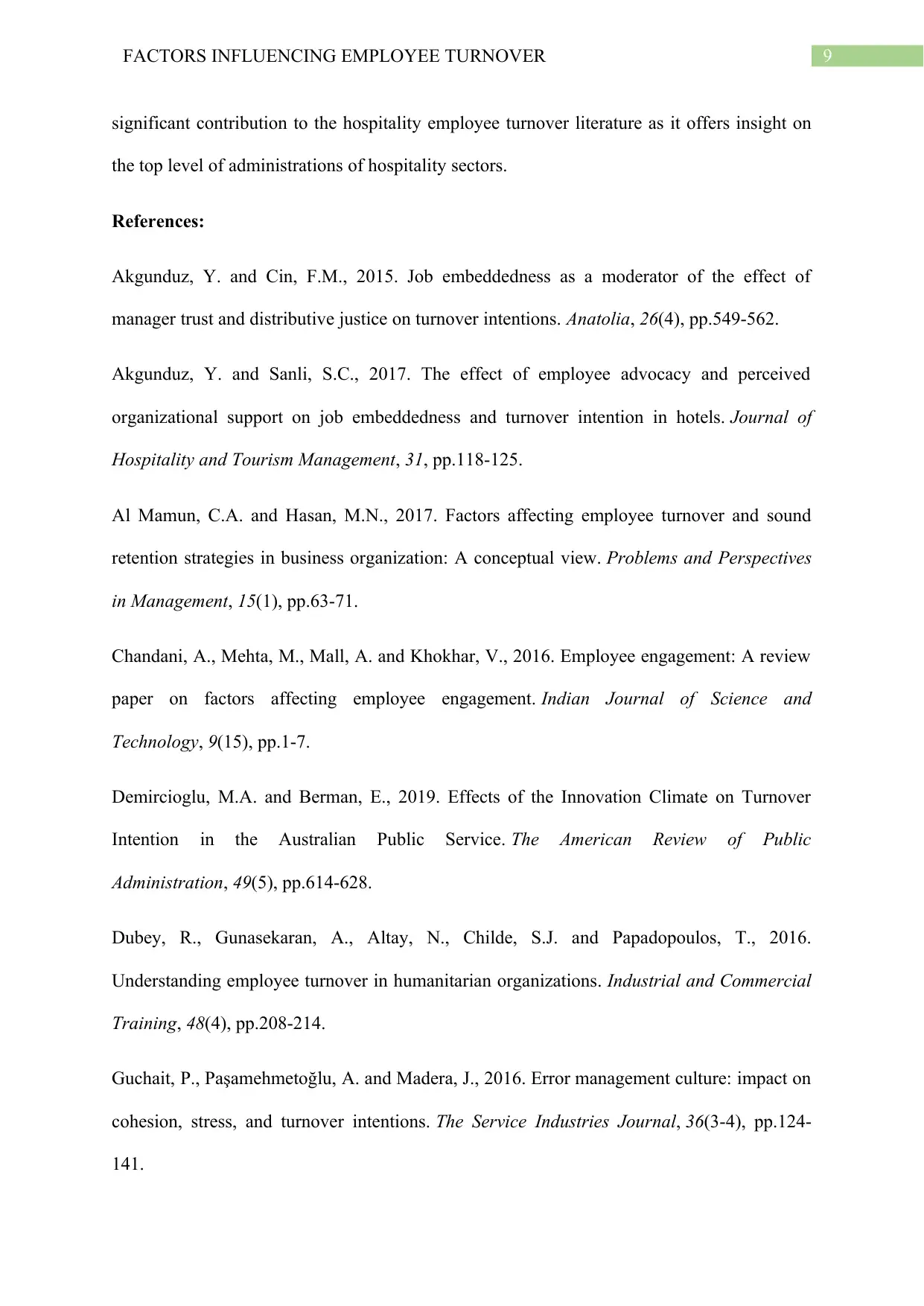
9FACTORS INFLUENCING EMPLOYEE TURNOVER
significant contribution to the hospitality employee turnover literature as it offers insight on
the top level of administrations of hospitality sectors.
References:
Akgunduz, Y. and Cin, F.M., 2015. Job embeddedness as a moderator of the effect of
manager trust and distributive justice on turnover intentions. Anatolia, 26(4), pp.549-562.
Akgunduz, Y. and Sanli, S.C., 2017. The effect of employee advocacy and perceived
organizational support on job embeddedness and turnover intention in hotels. Journal of
Hospitality and Tourism Management, 31, pp.118-125.
Al Mamun, C.A. and Hasan, M.N., 2017. Factors affecting employee turnover and sound
retention strategies in business organization: A conceptual view. Problems and Perspectives
in Management, 15(1), pp.63-71.
Chandani, A., Mehta, M., Mall, A. and Khokhar, V., 2016. Employee engagement: A review
paper on factors affecting employee engagement. Indian Journal of Science and
Technology, 9(15), pp.1-7.
Demircioglu, M.A. and Berman, E., 2019. Effects of the Innovation Climate on Turnover
Intention in the Australian Public Service. The American Review of Public
Administration, 49(5), pp.614-628.
Dubey, R., Gunasekaran, A., Altay, N., Childe, S.J. and Papadopoulos, T., 2016.
Understanding employee turnover in humanitarian organizations. Industrial and Commercial
Training, 48(4), pp.208-214.
Guchait, P., Paşamehmetoğlu, A. and Madera, J., 2016. Error management culture: impact on
cohesion, stress, and turnover intentions. The Service Industries Journal, 36(3-4), pp.124-
141.
significant contribution to the hospitality employee turnover literature as it offers insight on
the top level of administrations of hospitality sectors.
References:
Akgunduz, Y. and Cin, F.M., 2015. Job embeddedness as a moderator of the effect of
manager trust and distributive justice on turnover intentions. Anatolia, 26(4), pp.549-562.
Akgunduz, Y. and Sanli, S.C., 2017. The effect of employee advocacy and perceived
organizational support on job embeddedness and turnover intention in hotels. Journal of
Hospitality and Tourism Management, 31, pp.118-125.
Al Mamun, C.A. and Hasan, M.N., 2017. Factors affecting employee turnover and sound
retention strategies in business organization: A conceptual view. Problems and Perspectives
in Management, 15(1), pp.63-71.
Chandani, A., Mehta, M., Mall, A. and Khokhar, V., 2016. Employee engagement: A review
paper on factors affecting employee engagement. Indian Journal of Science and
Technology, 9(15), pp.1-7.
Demircioglu, M.A. and Berman, E., 2019. Effects of the Innovation Climate on Turnover
Intention in the Australian Public Service. The American Review of Public
Administration, 49(5), pp.614-628.
Dubey, R., Gunasekaran, A., Altay, N., Childe, S.J. and Papadopoulos, T., 2016.
Understanding employee turnover in humanitarian organizations. Industrial and Commercial
Training, 48(4), pp.208-214.
Guchait, P., Paşamehmetoğlu, A. and Madera, J., 2016. Error management culture: impact on
cohesion, stress, and turnover intentions. The Service Industries Journal, 36(3-4), pp.124-
141.
Secure Best Marks with AI Grader
Need help grading? Try our AI Grader for instant feedback on your assignments.
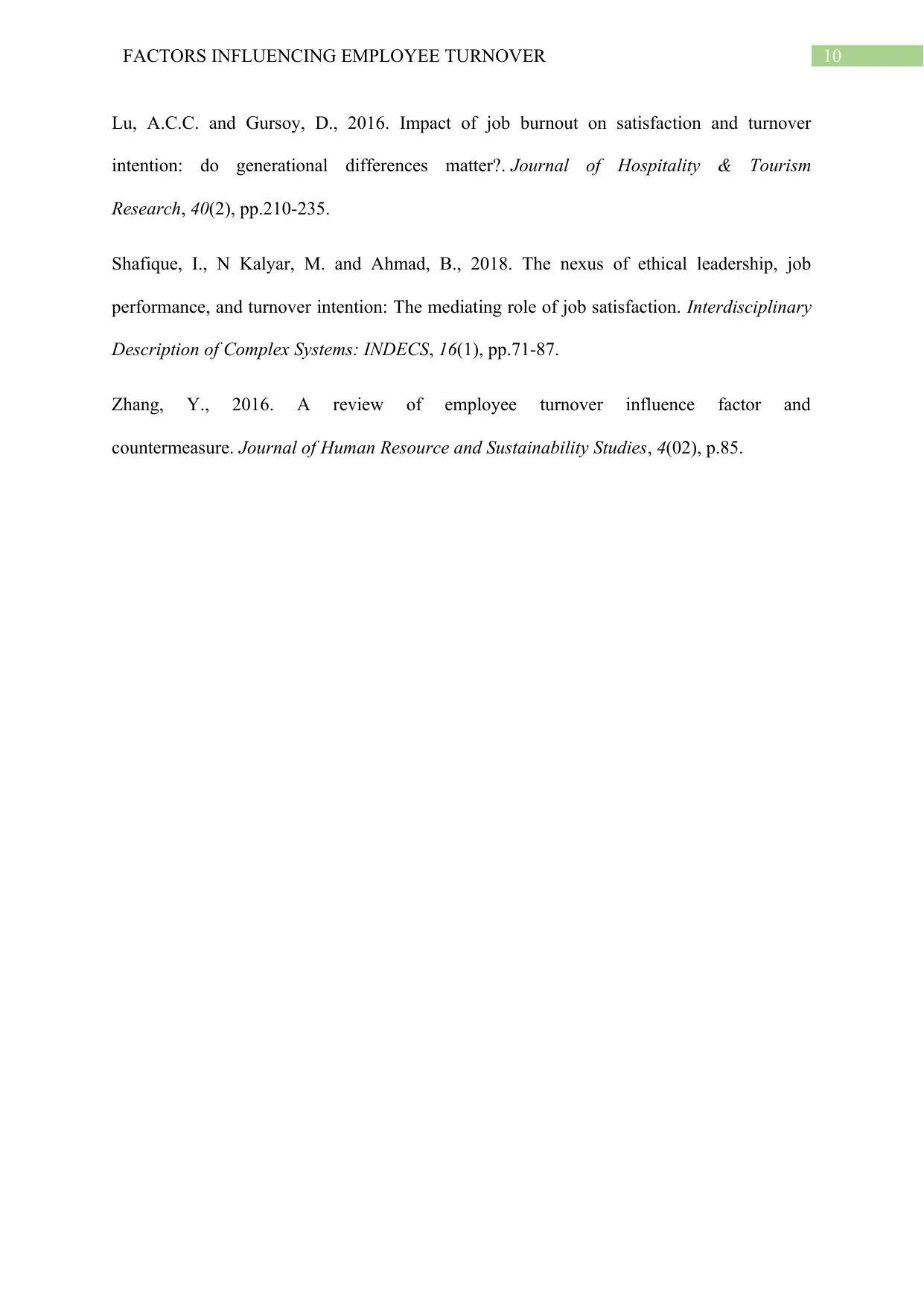
10FACTORS INFLUENCING EMPLOYEE TURNOVER
Lu, A.C.C. and Gursoy, D., 2016. Impact of job burnout on satisfaction and turnover
intention: do generational differences matter?. Journal of Hospitality & Tourism
Research, 40(2), pp.210-235.
Shafique, I., N Kalyar, M. and Ahmad, B., 2018. The nexus of ethical leadership, job
performance, and turnover intention: The mediating role of job satisfaction. Interdisciplinary
Description of Complex Systems: INDECS, 16(1), pp.71-87.
Zhang, Y., 2016. A review of employee turnover influence factor and
countermeasure. Journal of Human Resource and Sustainability Studies, 4(02), p.85.
Lu, A.C.C. and Gursoy, D., 2016. Impact of job burnout on satisfaction and turnover
intention: do generational differences matter?. Journal of Hospitality & Tourism
Research, 40(2), pp.210-235.
Shafique, I., N Kalyar, M. and Ahmad, B., 2018. The nexus of ethical leadership, job
performance, and turnover intention: The mediating role of job satisfaction. Interdisciplinary
Description of Complex Systems: INDECS, 16(1), pp.71-87.
Zhang, Y., 2016. A review of employee turnover influence factor and
countermeasure. Journal of Human Resource and Sustainability Studies, 4(02), p.85.
1 out of 11
Related Documents
Your All-in-One AI-Powered Toolkit for Academic Success.
+13062052269
info@desklib.com
Available 24*7 on WhatsApp / Email
![[object Object]](/_next/static/media/star-bottom.7253800d.svg)
Unlock your academic potential
© 2024 | Zucol Services PVT LTD | All rights reserved.




